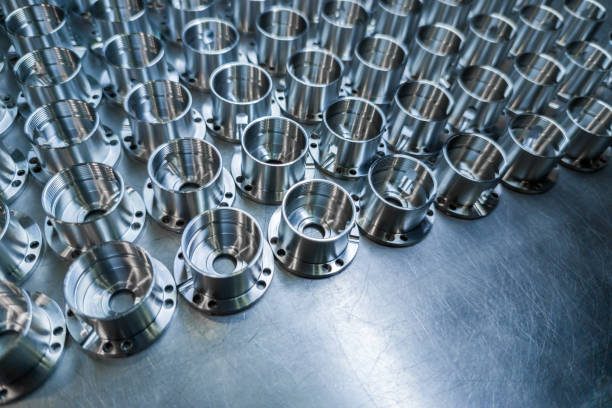How Precision Stamping Parts Drive Efficiency in Automotive Applications

Precision stamping is now regarded as one of the key methods in automotive production that ensures high quality and productivity of the components created. Mechanical adequacy, reliability, and light structure of the designed elements have provided significant improvements within the automotive industry allowing to push up the indicated benchmarks. The technology of precision machining and fabrication in the automobile industry can upgrade the efficiency of manufacturing processes, lower expenses and advance automobile performance. As it has been seen, Precision stamping parts are reviving new concepts in the automobile industry.
What are Precision Stamping Parts?
Precision stamping is a manufacturing process by which metals sheets are formed with high speed presses to a specific form through the use of a tool known as die. It is particularly famous for manufacturing components with a close tolerance range, which means high precision and almost identical products throughout the production line. Precision stamping parts are applied in a broad field with emphasis to the automotive field in the manufacture of engine parts, brackets, transmission systems, and structures.
In the recent past, the efficiency and accuracy of the stamping process have been enhanced by the use of enhanced technologies. When carried out in combination with stamping, precision machining and fabrication proves to be effective methods that enable manufacturers to meet the exacting standards of modern automobiles. Moreover, new ranges have been developed through CNC-controlled presses and automated systems to raise both the precision and productivity.
Today’s automotive industries in the metal stamping companies and precision machining providers have developed special services to fit different car components’ needs which are both strong and economical. They have made the application of precision stamping to be an essential component of the current automotive industry.
Survey of Major Uses of Precision Stamping in Automobile Industry
Precision stamping needs to be significantly considered in the automotive manufacturing processes, especially for high impact parts. For example, it is applied extensively to make engine brackets, heat shields and components for transmission that require both high temperature and mechanical strength. Spinner discs are also applied to suspension systems to provide strength and long life for components subject to movement and vibration.
Also, precision stamping plays an important role in development of light-weighting, particularly in the manufacture of chassis parts, bodying in and out panels and other structural parts. This is important with regard to increasing fuel economy and for compliance with high emission requirements.
It is also applied for producing complex connectors, terminals, and other a lot of electronic parts needed for reliable high-end cars such as EVs and vehicles with autonomous features. Working with a metal stamping firm allows the manufacturers to develop specific components according to the requirements of the automotive industry. These parts do not only increase performance, production efficiency and reliability, but also guarantee compliance with the existing regulations and norms within an industry.
Advantages of Precision Stamping Parts for Automobile Industry
The advantages of the precision stamping parts in the car industry are rather evident, and that is why such technology is more than suitable for high-production use. One of them being that it is cheaper than the traditional forms of advertising. Precision stamping enables the fabrication of numerous parts at a very high production rate while keeping the error rate low and the number of pieces per set low, thus the cost per set is low. This is specifically the case within the auto industry where coverage economies are very influential in preserving competitiveness.
Precision stamping also helps in setting up small and accurate parts, which plays an important role in setting up automotive industries that need some more safety and performance parameters to set for an automotive structure. Further, it provides for advanced materials like, aluminum, food grade stainless steel, high strength alloys so the makers are able to fabricate lightweight but hard wearing components.
Recent advancements in stamping also improve product design freedom in that geometries that may have been impossible to produce in the past can now be achieved in a single operation. When incorporated with precision machining and fabrication, manufacturers can now enhance the flow of processes even more to cater the ever growing need of new and advanced automotive technologies.
The Future of Precision Stamping in Automotive Manufacturing
Closely connected with the development of the automotive industry, precision stamping is going to be even more important for increasing vehicle performance and creating vehicles of the future with less negative impact on the environment. Within stamping processes, advancing technologies like the servo presses or integration of smart factory technology are allowing the manufacturers to increase automation of the processes and even better control of stamping technology.
These advancements also guarantee that the vibration system production cycles are fast, with shorter production time, better quality control and higher ability to adapt to dynamic market needs.
Sustainability will also feature basically on the future of precision stamping as a sector. Its time for industries involved in manufacturing stamping products to incorporate more environmentally friendly Type2 material use as well as using energy efficient processes. Light weight structure enhances vehicle performances; aluminium and composites reduce energy concern and hence sustainable automobile transportation.
Automotive manufacturers can therefore forge strategic alliances with progressive metal stamping companies to achieve the strategic industry goals and objectives through the development of new products that will meet industry requirements on performance and environmental conservation.
Also, since the implementation of electric vehicles (EVs) and other autonomous systems in transportation, then there will be significant need for precise stamping to manufacture the various parts required for the systems.
Conclusion
Precision stamped automotive parts are already finding a higher level of application in the automotive industry because they give certain unique benefits in terms of cost, accuracy and design flexibility. Ranging from engine parts to light structural panels, stamped automotive parts are critical tools to enhance the performance and sustainability of vehicles. Combining both precision machining and fabrication with stamping makes it easy to get the highest standards and productivity. Work with a trusted metal stamping company represents the possibility of obtaining precise technologies and specific solutions which are necessary for the automotive industry.
While automotive companies continue to seek out new challenges and opportunities, precision stamping will continue to be a key success story of modern manufacturing – helping firms around the world create higher-quality vehicles while driving environmental and technological change. Obtaining more precise stamping procedures and working with professionals in machining is crucial for survival in the contemporary market. Recent innovations in automotive stamping technologies and optimized materials promise a brilliant future for automotive production spurred by the effectiveness from the contemporary variants of stamping manufacturing.




